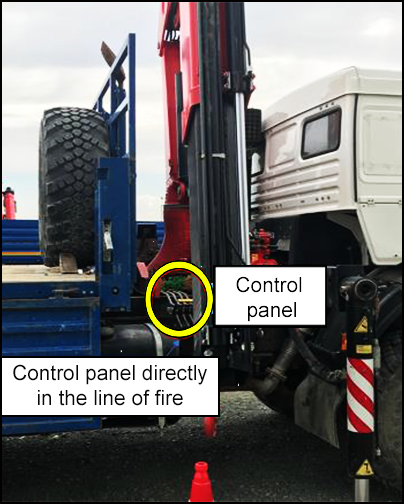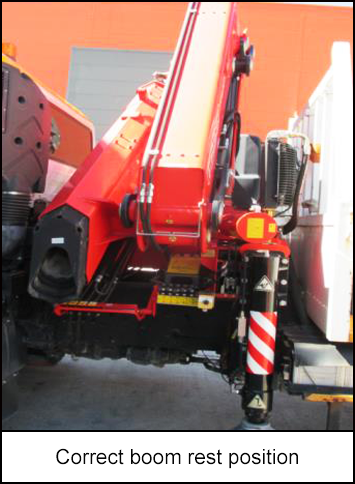-
What happened?
A crane operator completed a lifting (offloading) operation from a truck-mounted crane.
He then used the passenger side integrated control panel to retract and stow the boom into the rest position (transportation mode).
As the third section of the boom was being retracted, the operator was crushed between the truck components and the boom.

-
Why did it happen?
Crane can be operated from both driver and passenger side control panels.
Design of equipment allows operator to be in the line of fire if using the passenger side controls. In use, boom is behind the operator and not easily visible.
Original equipment manufacturer (OEM) operating manual prohibits stowing the crane’s boom to the rest position from passenger side.
Warning sign was not placed at the control panel on passenger side.
Folding the boom into the rest position was viewed as a ‘routine task’ and performed several times every day.
Supervision of the task limited to the lifting (offloading) operations but not the crane rig up/down (i.e. stowing of the boom to the rest position).

-
What did they learn?
Before lifting operations, check and ensure that:
- Truck mounted cranes are designed to avoid personnel being trapped by the boom. Replace with remote control systems.
- Hazard identification/job risk analysis covers scope of all activities (including crane mobilisation and demobilisation).
- Truck mounted crane’s stowing boom procedure is implemented in line with OEM operating manual.
- Lifting operation procedures are clear and available on site.
- Crane operator position at all stages of the lift is clearly identified, discussed and understood during the pre-job meeting.

-
Ask yourself or your crew
How can something like this happen here?
Why do you think the crane operator did what he did?
Do we use similarly designed equipment? When does our lifting equipment pose a risk to the operator?
What are the other hazards for today’s job?
What controls do we have in place to prevent this from happening here? How can we improve?
What else can we learn from this incident?

Add to homescreen
Content name
Select existing category:
Content name
New collection
Edit collection
What happened?
A crane operator completed a lifting (offloading) operation from a truck-mounted crane.
He then used the passenger side integrated control panel to retract and stow the boom into the rest position (transportation mode).
As the third section of the boom was being retracted, the operator was crushed between the truck components and the boom.

Why did it happen?
Crane can be operated from both driver and passenger side control panels.
Design of equipment allows operator to be in the line of fire if using the passenger side controls. In use, boom is behind the operator and not easily visible.
Original equipment manufacturer (OEM) operating manual prohibits stowing the crane’s boom to the rest position from passenger side.
Warning sign was not placed at the control panel on passenger side.
Folding the boom into the rest position was viewed as a ‘routine task’ and performed several times every day.
Supervision of the task limited to the lifting (offloading) operations but not the crane rig up/down (i.e. stowing of the boom to the rest position).
What did they learn?
Before lifting operations, check and ensure that:
- Truck mounted cranes are designed to avoid personnel being trapped by the boom. Replace with remote control systems.
- Hazard identification/job risk analysis covers scope of all activities (including crane mobilisation and demobilisation).
- Truck mounted crane’s stowing boom procedure is implemented in line with OEM operating manual.
- Lifting operation procedures are clear and available on site.
- Crane operator position at all stages of the lift is clearly identified, discussed and understood during the pre-job meeting.

Ask yourself or your crew
How can something like this happen here?
Why do you think the crane operator did what he did?
Do we use similarly designed equipment? When does our lifting equipment pose a risk to the operator?
What are the other hazards for today’s job?
What controls do we have in place to prevent this from happening here? How can we improve?
What else can we learn from this incident?
A crane operator used the passenger side integrated control panel to retract and stow the boom into the rest position (transportation mode). He was crushed between the control panel and the boom.














